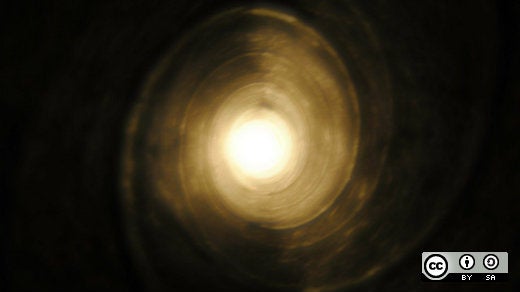Benjamin Franklin was known to say, "In this world nothing can be said to be certain, except death and taxes." There are open source solutions for completing your taxes, such as Open Tax Solver, but what about the other side of that quote? What does open source have to do with death? It's quite a lively subject, it seems. I know you are just dying to know, so let's dig in.
We all experience death and it becomes a long drawn out process of paperwork and burial rituals that we hope doesn't weigh too much on the loved ones we've left behind. The open source community has given this process some thought, not surprisingly. They've lent their mindshare towards rethinking how to deal with that final episode of life. It turns out, not only is open source great in life, but it comes in handy in death, too.
Take open source to the grave
The city of Bloomington, Indiana uses, and promotes, open source on their website. "The City is committed to using and contributing to open source software. Software that we write is licensed under GPL," it said. Their software can be found on GitHub. Bloomington has taken open source to the grave by creating a web interface for cemetery data at Rose Hill Cemetery that includes interments and deeds, which users can search through.
There are thousands of graveyards with an enormous amount of information associated with them. The most basic bit of information is the layout of the graves themselves. Records have been kept for years on paper and the layout of the cemetery itself was quite a cumbersome process.
Consider this instruction from the "American Association of Cemetery Superintendents Proceedings of the 23rd Annual Convention in 1909:" "After all the lots are staked temporarily, a rough plat or sketch of the section should be made, the lots given their proper numbers, and concrete corner posts prepared and set at the outside corners, or such other markers as may be decided on." Not exactly a command line function.
In May 2016 "Highlandskye" asked on StackExchange.com, a website of Q&A communities, for advice on transferring from paper to digital for two acres and 300 burial sites. There were several responses, but QGIS was the one most cited. Cemeteries can use QGIS to, as their website states, "create, edit, visualize, analyze, and publish geospatial information." Whether it's plotting out real estate or burial sites, locations and the information that goes with it, is the same. QGIS is available on GitHub.
Who's buried in Grant's Tomb?
Even if the graves are easy to find, some of the old ones can be hard to read due to weathering and bio-contamination. You can try doing a gravestone rubbing by hand to reveal names and dates or you can use open source photogrammetry, which is the science of making measurements from photographs, especially for recovering the exact positions of surface points, according to Wikipedia. OpenMVS (Multi-View Stereo) is one such tool. It is licensed under Mozilla Public License 2.0 and you can make 3D reconstructions from the images and by using Changchang Wu's VisualSFM (Structure From Motion), which is available on GitHub. Keith Hammond writes an overview of using open source tools for photogrammetry as an alternative to Autodesk's 123D Catch on Make.
Dial "M" for open source
There may be A Million Ways to Die in the West (a movie) and 1,000 Places to See Before You Die (a book), but murder is not a preferred method to do so. Murder, and crime in general, continue to plague society. The Murder Accountability Project is hoping to change that. The nonprofit uses data from federal, state, and local governments, and has logged about 600,000 homicides. Users can visit the website and comb the data and look for connections. The site was founded by retired reporter Thomas Hargrove.
Murder and open source even share time on the silver screen. The 2001 movie Antitrust, starring Tim Robbins, featured a murder and an emphasis on open source. In fact, Jon Hall, the executive director of Linux International, consulted on the film. Roger Ebert gave the film two stars.
Walk towards the light
Open source continues even past death for some. Ghost Box Hacks offers instructions on how to make "Ghost Box Radios" using Arduino, radio modules, and code. So, who ain't afraid of no ghost, huh?
Ghost hunting can be exhausting, but ParaDB, a web-based PHP/MySQL application released under GPL 2.0 can help kill the pain of collecting, organizing, and analyzing all the data the spirits may fling at you.
What if you are the spirit? This became personal for me two years ago, when my brother-in-law passed away. He was gone but his digital life lived on in the form of files, emails, text messages, social media profiles, etc. In some cases, we want to keep our loved one's digital footprint alive into perpetuity and sometimes we don't. In particular, I found closing social media accounts to be quite onerous. The Locker Project was one attempt at bringing together one's social and digital life into one place to save forever. The project, albeit five years old, can be found on GitHub.
People can prepare for the inevitable by archiving their digital life with open source archiving tools, such as Omeka. According to their website, you can "share your collections, display documents and oral histories, or create digital archives." That's one way to keep the family scrapbook going for years to come.
Whether you are alive—or not—it is important to consider that in certain ways your life will continue after you are gone and that your digital assets and even your earthly remains need to be accessible. Open source tools will help ease you through the transition and give your family and researchers a means to explore all that you have contributed to society during your time on Earth.
Live long and prosper, my friend.




Comments are closed.